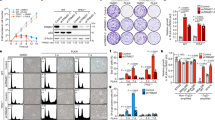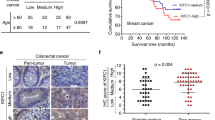Abstract
Centrosome amplification plays a key role in the origin of chromosomal instability during cancer development and progression. In this study, breast cancer cell lines with different p53 backgrounds were used to investigate the relationship between genotoxic stress, G1/S cell cycle checkpoint integrity, and the development of centrosome amplification. Introduction of DNA damage in the MCF-7 cell line by treatment with hydroxyurea (HU) or daunorubicin (DR) resulted in the arrest of both G1/S cell cycle progression and centriole duplication. In these cells, which carry functional p53, HU treatment also led to nuclear accumulation of p53 and p21WAF1, retinoblastoma hypophosphorylation, and downregulation of cyclin A. MCF-7 cells carrying a recombinant dominant-negative p53 mutant (vMCF-7DNp53) exhibited a shortened G1 phase of the cell cycle and retained a normal centrosome phenotype. However, these cells developed amplified centrosomes following HU treatment. The MDA-MB 231 cell line, which carries mutant p53 at both alleles, showed amplified centrosomes at the outset, and developed a hyperamplified centrosome phenotype following HU treatment. In cells carrying defective p53, the development of centrosome amplification also occurred following treatment with another DNA damaging agent, DR. Taken together, these findings demonstrate that loss of p53 function alone is not sufficient to drive centrosome amplification, but plays a critical role in this process following DNA damage through abrogation of the G1/S cell cycle checkpoint. Furthermore, these studies have important clinical implications because they suggest that breast cancers with compromised p53 function may develop centrosome amplification and consequent chromosomal instability following treatment with genotoxic anticancer drugs.
This is a preview of subscription content, access via your institution
Access options
Subscribe to this journal
Receive 50 print issues and online access
$259.00 per year
only $5.18 per issue
Buy this article
- Purchase on Springer Link
- Instant access to full article PDF
Prices may be subject to local taxes which are calculated during checkout







Similar content being viewed by others
References
Anbazhagan R, Gelber RD, Bettelheim R, Goldhirsch A and Gusterson BA . (1991). Ann. Oncol., 2, 47–53.
Angus SP, Fribourg AF, Markey MP, Williams SL, Horn HF, DeGregori J, Kowalik TF, Fukasawa K and Knudsen ES . (2002). Exp. Cell. Res., 276, 201–213.
Balczon R, Bao L, Zimmer WE, Brown K, Zinkowski RP and Brinkley BR . (1995). J. Cell. Biol., 130, 105–115.
Borel F, Lohez OD, Lacroix FB and Margolis RL . (2002). Proc. Natl. Acad. Sci. USA, 99, 9819–9824.
Brinkley BR . (2001). Trends Cell Biol., 11, 18–21.
D'Assoro AB, Barrett SL, Folk C, Negron VC, Boeneman K, Busby RC, Whitehead CM, Stivala F, Lingle LL and Salisbury JL . (2002a). Breast Cancer Res. Treat., 75, 25–34.
D'Assoro AB, Lingle WL and Salisbury JL . (2002b). Oncogene, 21, 6146–6153.
Duensing S and Munger K . (2002). Cancer Res., 62, 7075–7082.
Duensing S and Munger K . (2003). Crit. Rev. Eukaryot. Gene. Expr., 13, 9–23.
Faivre J, Frank-Vaillant M, Poulhe R, Mouly H, Jessus C, Brechot C and Sobczak-Thepot J . (2002). Oncogene, 21, 1493–1500.
Fry AM, Arnaud L and Nigg EA . (1999). J. Biol. Chem., 274, 16304–16310.
Fukasawa K, Choi T, Kuriyama R, Rulong S and Vande Woude GF . (1996). Science, 271, 1744–1747.
Gartel AL, Feliciano C and Tyner AL . (2003). Oncol. Res., 13, 405–408.
Goepfert TM, Adigun YE, Zhong L, Gay J, Medina D and Brinkley WR . (2002). Cancer Res., 62, 4115–4122.
Gunther T, Schneider-Stock R, Rys J, Niezabitowski A and Roessner A . (1997). J. Cancer Res. Clin. Oncol., 123, 388–394.
Hartwell LH and Weinert TA . (1989). Science, 246, 629–634.
Harvey M, Vogel H, Morris D, Bradley A, Bernstein A and Donehower LA . (1995). Nat. Genet., 9, 305–311.
Hinchcliffe EH, Li C, Thompson EA, Maller JL and Sluder G . (1999). Science, 283, 851–854.
Jin S and Levine AJ . (2001). J. Cell Sci., 114, 4139–4140.
Kellogg DR . (1989). Nature, 340, 99–100.
Khong HT and Restifo NP . (2002). Nat. Immunol., 3, 999–1005.
Kirschner M and Mitchison T . (1986). Cell, 45, 329–342.
Kramer A, Neben K and Ho AD . (2002). Leukemia, 16, 767–775.
Kronenwett U, Castro J, Roblick UJ, Fujioka K, Ostring C, Faridmoghaddam F, Laytragoon-Lewin N, Tribukait B and Auer G . (2003). BMC Cell Biol., 4, 8.
Lacey KR, Jackson PK and Stearns T . (1999). Proc. Natl. Acad. Sci. USA, 96, 2817–2822.
Lane DP and Benchimol S . (1990). Genes Dev., 4, 1–8.
Lengauer C, Kinzler KW and Vogelstein B . (1998). Nature, 396, 643–649.
Levine AJ, Momand J and Finlay CA . (1991). Nature, 351, 453–456.
Lingle WL, Barrett SL, Negron VC, D'Assoro AB, Boeneman K, Liu W, Whitehead CM, Reynolds C and Salisbury JL . (2002). Proc. Natl. Acad. Sci. USA, 99, 1978–1983.
Lingle WL, Lutz WH, Ingle JN, Maihle NJ and Salisbury JL . (1998). Proc. Natl. Acad. Sci. USA, 95, 2950–2955.
Lingle WL and Salisbury JL . (1999). Am. J. Pathol., 155, 1941–1951.
Loeb LA . (2001). Cancer Res., 61, 3230–3239.
Meraldi P, Lukas J, Fry A, Bartek J and Nigg E . (1999). Nat. Cell Biol., 1, 88–93.
Mgbonyebi OP, Russo J and Russo IH . (1999). Cancer Res., 59, 1903–1910.
Murphy KL and Rosen JM . (2000). Oncogene, 19, 1045–1051.
Mussman JG, Horn HF, Carroll PE, Okuda M, Tarapore P, Donehower LA and Fukasawa K . (2000). Oncogene, 19, 1635–1646.
Okuda M . (2002). Oncogene, 21, 6170–6174.
Palazzo RE . (2003). Cell Motil. Cytoskeleton, 54, 148–154.
Pihan GA, Purohit A, Wallace J, Malhotra R, Liotta L and Doxsey SJ . (2001). Cancer Res., 61, 2212–2219.
Pihan GA, Wallace J, Zhou Y and Doxsey SJ . (2003). Cancer Res., 63, 1398–1404.
Pinto AE, Andre S, Mendonca E, Silva G and Soares J . (2003). Int. J. Biol. Markers, 18, 7–12.
Riley RR, Duensing S, Brake T, Munger K, Lambert PF and Arbeit JM . (2003). Cancer Res., 63, 4862–4871.
Rubin EH and William NH . (2003). Cancer Medicine 6, Bast RC, Kufe DW, Pollock RE, Weichselbaum RR, Holland JF, Frei E (eds). BC Decker Inc.: Hamilton Canada, pp 781–788.
Sakano K, Oikawa S, Hasegawa K and Kawanishi S . (2001). Jpn. J. Cancer Res., 92, 1166–1174.
Senderowicz AM . (2003). Oncogene, 22, 6609–6620.
Sluder G and Hinchcliffe EH . (2000). Centrosome in Cell Replication and Early Development, Vol. 49: Current Topics in Developmental Biology. Academic Press: San Diego, pp 267–289.
Tarapore P and Fukasawa K . (2002). Oncogene, 21, 6234–6240.
Tarapore P, Horn HF, Tokuyama Y and Fukasawa K . (2001). Oncogene, 20, 3173–3184.
Taylor WR and Stark GR . (2001). Oncogene, 20, 1803–1815.
Wang XW, Zhan Q, Coursen JD, Khan MA, Kontny HU, Yu L, Hollander MC, O'Connor PM, Fornace Jr AJ and Harris CC . (1999). Proc. Natl. Acad. Sci. USA, 96, 3706–3711.
Wenger CR, Beardslee S, Owens MA, Pounds G, Oldaker T, Vendely P, Pandian MR, Harrington D, Clark GM and McGuire WL . (1993). Breast Cancer Res. Treat., 28, 9–20.
Acknowledgements
We thank Dr W Lingle and Mr Ilie Acu for helpful comments on the manuscript. This work was supported by NCI CA72836 to JLS, USAMRMC BC022276 to ABD, and the Mayo Clinic Foundation.
Author information
Authors and Affiliations
Corresponding author
Rights and permissions
About this article
Cite this article
D'Assoro, A., Busby, R., Suino, K. et al. Genotoxic stress leads to centrosome amplification in breast cancer cell lines that have an inactive G1/S cell cycle checkpoint. Oncogene 23, 4068–4075 (2004). https://doi.org/10.1038/sj.onc.1207568
Received:
Revised:
Accepted:
Published:
Issue Date:
DOI: https://doi.org/10.1038/sj.onc.1207568
Keywords
This article is cited by
-
Epigenetic alterations impede epithelial-mesenchymal transition by modulating centrosome amplification and Myc/RAS axis in triple negative breast cancer cells
Scientific Reports (2023)
-
A linear programming computational framework integrates phosphor-proteomics and prior knowledge to predict drug efficacy
BMC Systems Biology (2017)
-
Centrosome amplification, chromosomal instability and cancer: mechanistic, clinical and therapeutic issues
Chromosome Research (2016)
-
The mitotic kinase Aurora-A promotes distant metastases by inducing epithelial-to-mesenchymal transition in ERα+ breast cancer cells
Oncogene (2014)
-
Quantitative multi-parametric evaluation of centrosome declustering drugs: centrosome amplification, mitotic phenotype, cell cycle and death
Cell Death & Disease (2014)



